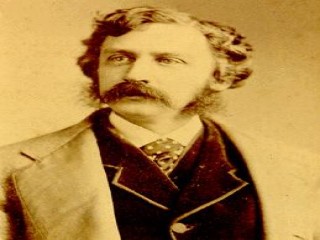
Bret Harte biography
Date of birth : 1836-08-25
Date of death : 1902-05-05
Birthplace : Albany, New York
Nationality : American
Category : Famous Figures
Last modified : 2011-05-10
Credited as : Author and poet, The Luck of Roaring Camp, Tales of the Argonauts
Francis Brett Harte, known as Bret Harte, an American poet and fiction writer who specialized in local color and regional stories, set the fashion in fiction for a number of writers in the era following the Civil War.
Bret Harte, born in Albany, N.Y., had a somewhat sketchy education in the East before he followed his widowed and recently remarried mother and her family to the Pacific Coast in 1854. There he taught school for a year, visited the Mother Lode mining country, and worked briefly for an express company.
Harte got his professional start between 1857 and 1860, when he was a journalist in Union, Calif. He moved to San Francisco, worked in government offices, and contributed writings to the Golden Era and the Californian which brought him prominence in literary circles. A collection of poems, The Lost Galleon, and a volume of parodies, Condensed Novels, appeared in 1867. The next year Harte became editor of a new West Coast magazine, Overland Monthly, and began to write a series of local sketches.
When stories set in the mining country, such as "The Luck of Roaring Camp" and "The Outcasts of Poker Flat, " were read and reprinted in the East and elsewhere, Harte skyrocketed to fame. His renown increased when his comic ballad "Plain Language from Truthful James" relating how Ah Sin, a Chinese gambler, outwitted two confidence men-became nationally famous.
By the time Harte's first collection of western local-color stories appeared in book form in 1870, eastern publishers were competing for Harte's services. In 1871 he signed a contract with the Atlantic Monthly at a record figure for an American writer—$10, 000 for 12 monthly contributions. He left California, never to return, and journeyed eastward, receiving a triumphant welcome everywhere.
It seemed to his contemporaries that Harte had written the first authentic fiction about gold rush California on the basis of intimate knowledge. Actually he had arrived in the West several years too late, and was in the mining camps too briefly, to know them intimately. He did what most authors who achieve immediate success do—combined old elements with new ones in a way that initially seemed to be quite novel.
For one thing, Harte used the techniques of the fiction writer most popular in America during the 1860s, Charles Dickens—despite the deft parody of Dickens included in Condensed Novels. Harte repeatedly borrowed some of the very elements he had burlesqued—the linking of settings with moods and actions, and the creation of memorable characters by assigning them unusual names and grotesquely incongruous characteristics.
Harte also owed a debt to the most popular American writers of the day: the native humorists. He himself claimed that the unique qualities of the American short story derived from the native comic story, and in describing this genre he might well have been analyzing his own narratives: "condensed, yet suggestive … delightfully extravagant—or a miracle of understatement. It voiced not only the dialect, but the habits of thought of a people or locality … often irreverent; it was devoid of all moral responsibility."
Like antebellum humorists, Harte stressed regional characters and mores. Like postbellum humorists, he used a style marked by fanciful figures of speech, unusual word combinations, and eccentrically shaped sentences. Not surprisingly, despite his frequent pathos, Harte was classified often as a humorist.
When Harte appeared on the scene, American popular fiction was largely preachy and sentimental, showing noble characters doing noble deeds. The new ingredient in Harte's typical tale was another kind of character: his rough miners, prostitutes, dance hall girls, gamblers, and badmen proved that beneath their rugged exteriors beat hearts of gold. Many of these characters became stereo-types in western fiction, particularly in cowboy stories; so did others, such as the schoolmarm imported from the East and the aristocratic colonel from the South.
These qualities appeared in early tales and in later collections: Mrs. Skagg's Husbands (1873), Tales of the Argonauts (1875), An Heiress of Red Dog and Other Sketches (1878), and Colonel Starbottle's Client, and Some Other People (1892); and in novels: M'Liss (1873), Gabriel Conroy (1876), and Jeff Briggs's Love Story (1880).
As time passed, it became clear that Harte was repeating himself and that his powers—except in an occasional story—were waning. Two plays, one written in collaboration with Mark Twain, were failures. Domestic difficulties and personal problems were factors that prompted Harte to accept United States consulships in Germany and in Scotland. He went to London in 1885 and stayed there for the last 17 years of his life. His considerable reputation deteriorated steadily, and scholars eventually agreed that his chief importance derived from the fact that he set a fashion in fiction writing that would be adopted by many American writers, some of them great.
















